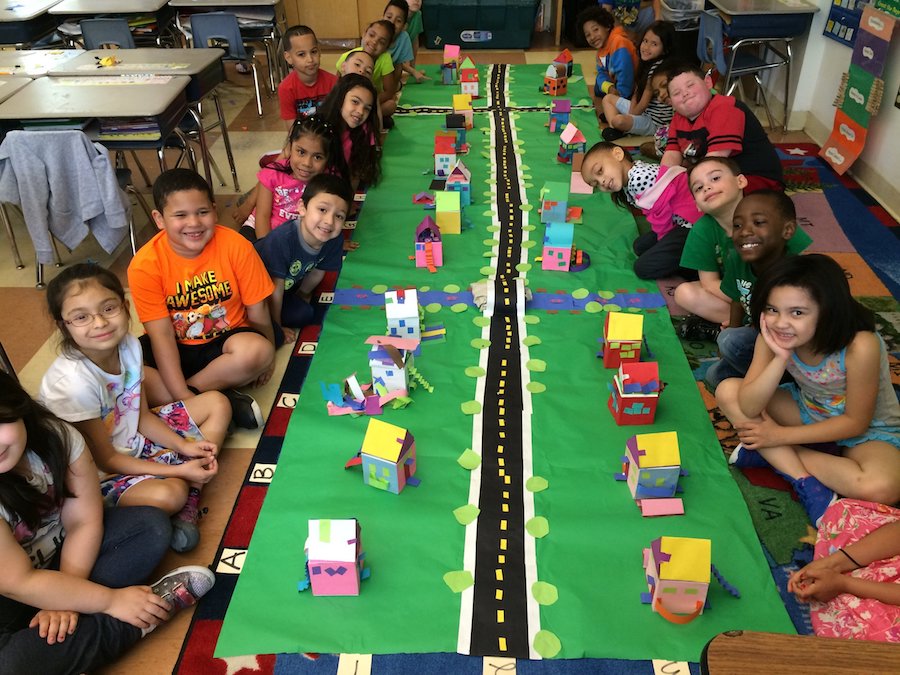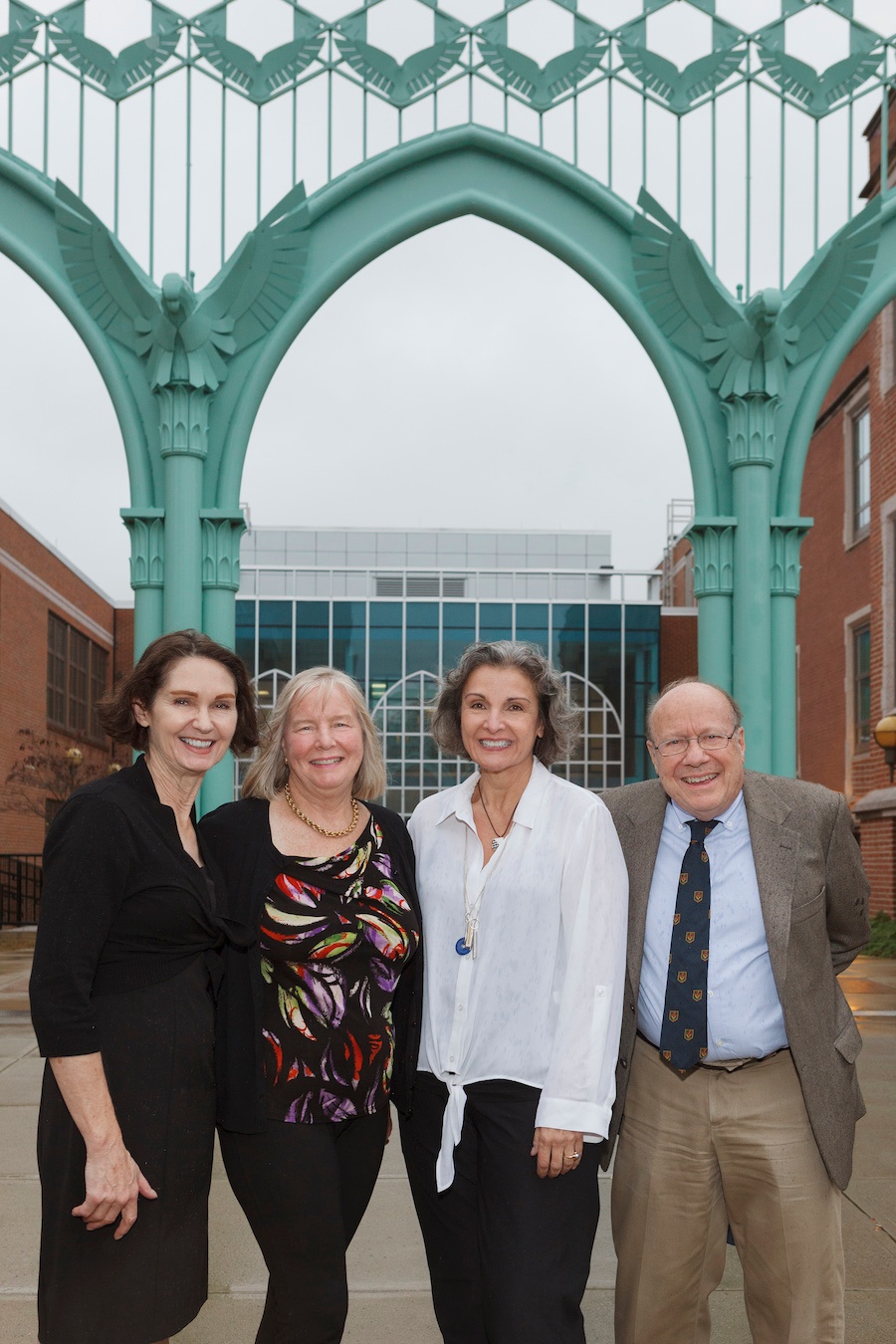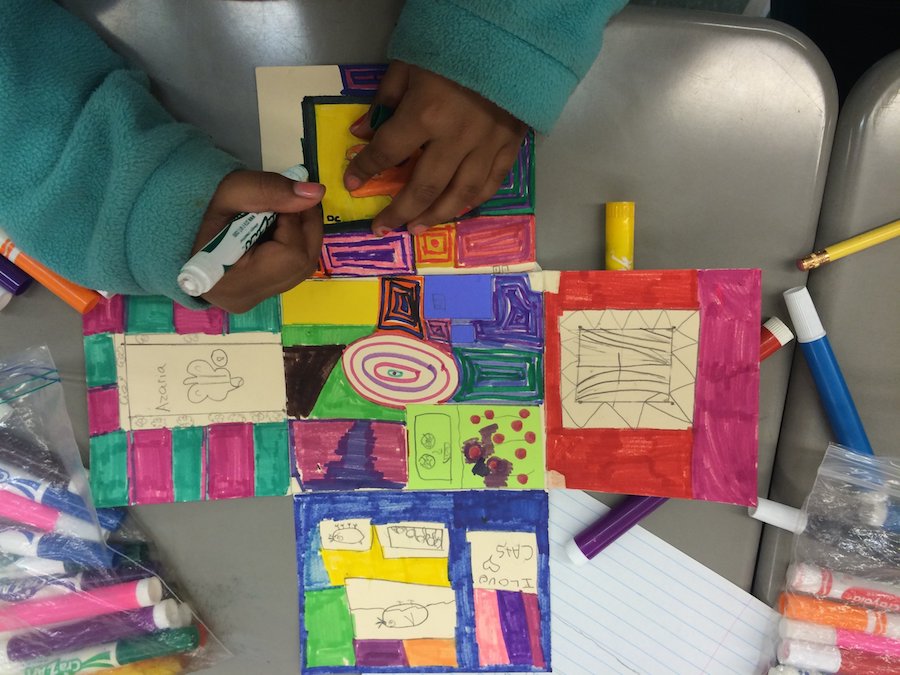
Kids in the ARC's first-grade module: "My House: Design Connections Partnership." ARC Photo.
Architect Anna Sanko has this trick. It starts with a sturdy strip of paper, no thicker than two inches. She folds it. Then she folds it again. And again. Then she looks out, into rows of chairs before her, where students are sitting on the edges of their seats. Every time, their eyes are on her, unblinking.
“Okay,” she says. “Find your chair.” Eyes and mouths open as kids scramble to make their chairs happen. And one by one, they always do. Little paper seats, accordion-like across a sea of desks, waiting for a room to be placed in.

Sanko and ARC mwmbers. Harold Shapiro Photos.
Sanko is the director of the Architecture Resource Center (ARC), a nonprofit designed to teach kids about architecture and design through hands-on, practical experience and design projects made for their age groups. This year, it turns a quarter century old, and looks ahead to the next 25 years.
“When I work with students, we’re solving a design problem,” Sanko said in an interview Monday, pulling out lesson plans and photos as she spoke. “This is a math program, but we get to talk about everything. We’re doing art, but then we’re doing the math … they’re measuring. They’re cutting. They’re drawing.”
“What I say to them is: They don’t have to be able to do everything in this room. What they have to be able to do is ask questions … to be able to do is the research behind it to get the answer to their question. It’s ways of communicating and also how to work on a team.”
That's partly because building and sustaining ARC itself has been a team effort. The organization has humble beginnings: a $25,000 grant from the National Endowment for the Arts in 1991. When Sanko started it in the 1990s with design-based teaching and lesson plans, she said she didn’t have much support behind her. What she thought would be a “no brainer” for teachers and their schools—pitching design as a way of learning math, art, architecture and history—was met with strong opposition. Schools insisted they didn't have the funding to do it, or the interest.
There were a few holdouts—teachers at her daughter's school, who saw the work she was doing and asked if she could expand it in a way that students understood. Then the NEA, which continued to fund the organization as its programming grew. Finally schools, who moved the lessons from arts to social studies, then social studies to math.
Over the 25 years since, Sanko has devised lesson plans for thousands of students statewide and nationally, including hundreds of New Haven first through fourth graders each year. Working in five, 90-minute sessions, students start their projects in first grade by constructing a city plan, complete with long, marked roads, tree-lined streets, sidewalks and single-family homes.

One of the bedrooms that third graders design. ARC photo.
As students get older, projects become more challenging: a playhouse in second grade, foldable, single-person bedroom in third, and a two-person dorm room in forth. In each, Sanko presses students to factor space between homes, area and perimeter of rooms, and the weight that each building will need to support, the price differentials that materials carry. What doesn’t cease to be amazing to her, she said, is that the students tend to do the rest.
“It’s all about life learning, and process, and reflection,” she said. “We come up with design problems that are relevant to their life and connect the classroom to the curriculum that they’re using. It’s an application of the real world and relevant to their life.”
The dorm room project, she added, is "especially exciting because we get to talk about: What does it mean to go away to school? What do I have to do to get there?"
But that one, she's saving for next year. Currently, Sanko is working with 600 New Haven third graders to plan model bedroom. She starts by posing a series of questions to students. Like: Who is going to use it? How does one need to arrange it? How does ADA accessibility factor in? Classes tend to pick it up and run with it, factoring in furniture, body weight, and what kind of usage the room will get.
“It’s push-pull, push-pull. It’s finding that happy balance," she said of working with a few who take a while to warm up to math. But “I learn so much from them every day. Architecture is a team activity. Life is a team activity. Everything we’re doing is right around us.”
Throughout the month of November, The Arts Paper will be profiling winners of the 2017 Arts Awards. Those winners are: Rev. Kevin Ewing, Stetson Branch Manager Diane Brown, New Haven’s Nasty Women Exhibition, the Architecture Resource Center (ARC) and Musical Intervention. Jock Reynolds will be receiving The C. Newton Schenck III Award for Lifetime Achievement in and Contribution to the Arts. This is our fourth of five installments.